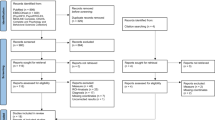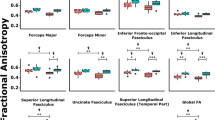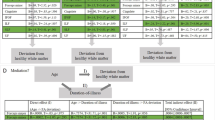Abstract
White matter (WM) abnormalities have long been suspected in obsessive–compulsive disorder (OCD) but the available evidence has been inconsistent. We conducted the first multimodal meta-analysis of WM volume (WMV) and fractional anisotropy (FA) studies in OCD. All voxel-wise studies comparing WMV or FA between patients with OCD and healthy controls in the PubMed, ScienceDirect, Google Scholar, Web of Knowledge and Scopus databases were retrieved. Manual searches were also conducted and authors were contacted soliciting additional data. Thirty-four data sets were identified, of which 22 met inclusion criteria (five of them unpublished; comprising 537 adult and pediatric patients with OCD and 575 matched healthy controls). Whenever possible, raw statistical parametric maps were also obtained from the authors. Peak and raw WMV and FA data were combined using novel multimodal meta-analytic methods implemented in effect-size signed differential mapping. Patients with OCD showed widespread WM abnormalities, but findings were particularly robust in the anterior midline tracts (crossing between anterior parts of cingulum bundle and body of corpus callosum), which showed both increased WMV and decreased FA, possibly suggesting an increase of fiber crossing in these regions. This finding was also observed when the analysis was limited to adult participants, and especially pronounced in samples with a higher proportion of medicated patients. Therefore, patients with OCD may have widespread WM abnormalities, particularly evident in anterior midline tracts, although these changes might be, at least in part, attributable to the effects of therapeutic drugs.
Similar content being viewed by others
Log in or create a free account to read this content
Gain free access to this article, as well as selected content from this journal and more on nature.com
or
References
Admon R, Bleich-Cohen M, Weizmant R, Poyurovsky M, Faragian S, Hendler T (2012). Functional and structural neural indices of risk aversion in obsessive-compulsive disorder (OCD). Psychiatry Res 203: 207–213.
Avants BB, Epstein CL, Grossman M, Gee JC (2008). Symmetric diffeomorphic image registration with cross-correlation: evaluating automated labeling of elderly and neurodegenerative brain. Med Image Anal 12: 26–41.
Ballantine HT Jr, Bouckoms AJ, Thomas EK, Giriunas IE (1987). Treatment of psychiatric illness by stereotactic cingulotomy. Biol Psychiatry 22: 807–819.
Benedetti F, Giacosa C, Radaelli D, Poletti S, Pozzi E, Dallaspezia S et al (2013). Widespread changes of white matter microstructure in obsessive-compulsive disorder: effect of drug status. Eur Neuropsychopharmacol 23: 581–593.
Cannistraro PA, Makris N, Howard JD, Wedig MM, Hodge SM, Wilhelm S et al (2007). A diffusion tensor imaging study of white matter in obsessive-compulsive disorder. Depress Anxiety 24: 440–446.
Carmona S, Bassas N, Rovira M, Gispert JD, Soliva JC, Prado M et al (2007). Pediatric OCD structural brain deficits in conflict monitoring circuits: a voxel-based morphometry study. Neurosci Lett 421: 218–223.
Catani M, Dell'acqua F, Vergani F, Malik F, Hodge H, Roy P et al (2012). Short frontal lobe connections of the human brain. Cortex 48: 273–291.
Daniele A, Bartolomeo P, Cassetta E, Bentivoglio AR, Gainotti G, Albanese A et al (1997). Obsessive-compulsive behaviour and cognitive impairment in a parkinsonian patient after left putaminal lesion. J Neurol Neurosurg Psychiatry 62: 288–289.
de Wit SJ, Alonso P, Schweren L, Mataix-Cols D, Lochner C, Menchon JM et al (2013). Multicenter voxel-based morphometry mega-analysis of structural brain scans in obsessive-compulsive disorder. Am J Psychiatry doi:10.1176/appi.ajp.2013.13040574.
Duran FL, Hoexter MQ, Valente AA Jr, Miguel EC, Busatto GF (2009). Association between symptom severity and internal capsule volume in obsessive-compulsive disorder. Neurosci Lett 452: 68–71.
Fan Q, Yan X, Wang J, Chen Y, Wang X, Li C et al (2012). Abnormalities of white matter microstructure in unmedicated obsessive-compulsive disorder and changes after medication. PLoS One 7: e35889.
Fontenelle LF, Harrison BJ, Yucel M, Pujol J, Fujiwara H, Pantelis C (2009). Is there evidence of brain white-matter abnormalities in obsessive-compulsive disorder?: a narrative review. Top Magn Reson Imaging 20: 291–298.
Garibotto V, Scifo P, Gorini A, Alonso CR, Brambati S, Bellodi L et al (2010). Disorganization of anatomical connectivity in obsessive compulsive disorder: a multi-parameter diffusion tensor imaging study in a subpopulation of patients. Neurobiol Dis 37: 468–476.
Gruner P, Vo A, Ikuta T, Mahon K, Peters BD, Malhotra AK et al (2012). White matter abnormalities in pediatric obsessive-compulsive disorder. Neuropsychopharmacology 37: 2730–2739.
Ha TH, Kang DH, Park JS, Jang JH, Jung WH, Choi JS et al (2009). White matter alterations in male patients with obsessive-compulsive disorder. Neuroreport 20: 735–739.
Harrison BJ, Soriano-Mas C, Pujol J, Ortiz H, Lopez-Sola M, Hernandez-Ribas R et al (2009). Altered corticostriatal functional connectivity in obsessive-compulsive disorder. Arch Gen Psychiatry 66: 1189–1200.
Koprivova J, Hor cek J, Tintera J, Prasko J, Raszka M, Ibrahim I et al (2009). Medial frontal and dorsal cortical morphometric abnormalities are related to obsessive-compulsive disorder. Neurosci Lett 464: 62–66.
Lazaro L, Castro-Fornieles J, Cullell C, Andres S, Falcon C, Calvo R et al (2011). A voxel-based morphometric MRI study of stabilized obsessive-compulsive adolescent patients. Prog Neuropsychopharmacol Biol Psychiatry 35: 1863–1869.
Li F, Huang X, Yang Y, Li B, Wu Q, Zhang T et al (2011). Microstructural brain abnormalities in patients with obsessive-compulsive disorder: diffusion-tensor MR imaging study at 3.0T. Radiology 260: 216–223.
Mataix-Cols D, Rosario-Campos MC, Leckman JF (2005). A multidimensional model of obsessive-compulsive disorder. Am J Psychiatry 162: 228–238.
Mataix-Cols D, van den Heuvel OA (2006). Common and distinct neural correlates of obsessive-compulsive and related disorders. Psychiatr Clin North Am 29: 391–410, viii.
Matsumoto R, Ito H, Takahashi H, Ando T, Fujimura Y, Nakayama K et al (2010). Reduced gray matter volume of dorsal cingulate cortex in patients with obsessive-compulsive disorder: a voxel-based morphometric study. Psychiatry Clin Neurosci 64: 541–547.
Menzies L, Chamberlain SR, Laird AR, Thelen SM, Sahakian BJ, Bullmore ET (2008a). Integrating evidence from neuroimaging and neuropsychological studies of obsessive-compulsive disorder: the orbitofronto-striatal model revisited. Neurosci Biobehav Rev 32: 525–549.
Menzies L, Williams GB, Chamberlain SR, Ooi C, Fineberg N, Suckling J et al (2008b). White matter abnormalities in patients with obsessive-compulsive disorder and their first-degree relatives. Am J Psychiatry 165: 1308–1315.
Milad MR, Rauch SL (2011). Obsessive-compulsive disorder: beyond segregated cortico-striatal pathways. Trends Cogn Sci 16: 43–51.
Nakamae T, Narumoto J, Shibata K, Matsumoto R, Kitabayashi Y, Yoshida T et al (2008). Alteration of fractional anisotropy and apparent diffusion coefficient in obsessive-compulsive disorder: a diffusion tensor imaging study. Prog Neuropsychopharmacol Biol Psychiatry 32: 1221–1226.
Peng Z, Lui SS, Cheung EF, Jin Z, Miao G, Jing J et al (2012). Brain structural abnormalities in obsessive-compulsive disorder: converging evidence from white matter and grey matter. Asian J Psychiatr 5: 290–296.
Peters BD, Szeszko PR, Radua J, Ikuta T, Gruner P, DeRosse P et al (2012). White matter development in adolescence: diffusion tensor imaging and meta-analytic results. Schizophr Bull 38: 1308–1317.
Pujol J, Soriano-Mas C, Alonso P, Cardoner N, Menchon JM, Deus J et al (2004). Mapping structural brain alterations in obsessive-compulsive disorder. Arch Gen Psychiatry 61: 720–730.
Radua J, Borgwardt S, Crescini A, Mataix-Cols D, Meyer-Lindenberg A, McGuire PK et al (2012a). Multimodal meta-analysis of structural and functional brain changes in first episode psychosis and the effects of antipsychotic medication. Neurosci Biobehav Rev 36: 2325–2333.
Radua J, Canales-Rodríguez EJ, Pomarol-Clotet E, Salvador R (2013a). Validity of modulation and optimal settings for advanced voxel-based morphometry. Neuroimage 86: 81–90.
Radua J, Mataix-Cols D (2009). Voxel-wise meta-analysis of grey matter changes in obsessive-compulsive disorder. Br J Psychiatry 195: 393–402.
Radua J, Mataix-Cols D, Phillips ML, El-Hage W, Kronhaus DM, Cardoner N et al (2012b). A new meta-analytic method for neuroimaging studies that combines reported peak coordinates and statistical parametric maps. Eur Psychiatry 27: 605–611.
Radua J, Romeo M, Mataix-Cols D, Fusar-Poli P (2013b). A general approach for combining voxel-based meta-analyses conducted in different neuroimaging modalities. Curr Med Chem 20: 462–466.
Radua J, van den Heuvel OA, Surguladze S, Mataix-Cols D (2010). Meta-analytical comparison of voxel-based morphometry studies in obsessive-compulsive disorder vs other anxiety disorders. Arch Gen Psychiatry 67: 701–711.
Radua J, Via E, Catani M, Mataix-Cols D (2011). Voxel-based meta-analysis of regional white-matter volume differences in autism spectrum disorder versus healthy controls. Psychol Med 41: 1539–1550.
Rauch SL, Jenike MA, Alpert NM, Baer L, Breiter HC, Savage CR et al (1994). Regional cerebral blood flow measured during symptom provocation in obsessive-compulsive disorder using oxygen 15-labeled carbon dioxide and positron emission tomography. Arch Gen Psychiatry 51: 62–70.
Riffkin J, Yucel M, Maruff P, Wood SJ, Soulsby B, Olver J et al (2005). A manual and automated MRI study of anterior cingulate and orbito-frontal cortices, and caudate nucleus in obsessive-compulsive disorder: comparison with healthy controls and patients with schizophrenia. Psychiatry Res 138: 99–113.
Rotge JY, Langbour N, Guehl D, Bioulac B, Jaafari N, Allard M et al (2009). Gray matter alterations in obsessive-compulsive disorder: an anatomic likelihood estimation meta-analysis. Neuropsychopharmacology 35: 686–691.
Saxena S, Rauch SL (2000). Functional neuroimaging and the neuroanatomy of obsessive-compulsive disorder. Psychiatr Clin North Am 23: 563–586.
Sijens PE, Mostert JP, Irwan R, Potze JH, Oudkerk M, De Keyser J (2008). Impact of fluoxetine on the human brain in multiple sclerosis as quantified by proton magnetic resonance spectroscopy and diffusion tensor imaging. Psychiatry Res 164: 274–282.
Swedo SE, Schapiro MB, Grady CL, Cheslow DL, Leonard HL, Kumar A et al (1989). Cerebral glucose metabolism in childhood-onset obsessive-compulsive disorder. Arch Gen Psychiatry 46: 518–523.
Szeszko PR, Ardekani BA, Ashtari M, Malhotra AK, Robinson DG, Bilder RM et al (2005). White matter abnormalities in obsessive-compulsive disorder: a diffusion tensor imaging study. Arch Gen Psychiatry 62: 782–790.
Thiebaut de Schotten M, Dell'Acqua F, Valabregue R, Catani M (2012). Monkey to human comparative anatomy of the frontal lobe association tracts. Cortex 48: 82–96.
Togao O, Yoshiura T, Nakao T, Nabeyama M, Sanematsu H, Nakagawa A et al (2010). Regional gray and white matter volume abnormalities in obsessive-compulsive disorder: a voxel-based morphometry study. Psychiatry Res 184: 29–37.
van den Heuvel OA, Remijnse PL, Mataix-Cols D, Vrenken H, Groenewegen HJ, Uylings HB et al (2009). The major symptom dimensions of obsessive-compulsive disorder are mediated by partially distinct neural systems. Brain 132 (Pt 4): 853–868.
van den Heuvel OA, Veltman DJ, Groenewegen HJ, Cath DC, van Balkom AJ, van Hartskamp J et al (2005). Frontal-striatal dysfunction during planning in obsessive-compulsive disorder. Arch Gen Psychiatry 62: 301–309.
van Tol MJ, van der Wee NJ, van den Heuvel OA, Nielen MM, Demenescu LR, Aleman A et al (2010). Regional brain volume in depression and anxiety disorders. Arch Gen Psychiatry 67: 1002–1011.
Yoo SY, Jang JH, Shin YW, Kim DJ, Park HJ, Moon WJ et al (2007). White matter abnormalities in drug-naive patients with obsessive-compulsive disorder: a diffusion tensor study before and after citalopram treatment. Acta Psychiatr Scand 116: 211–219.
Yoo SY, Roh MS, Choi JS, Kang DH, Ha TH, Lee JM et al (2008). Voxel-based morphometry study of gray matter abnormalities in obsessive-compulsive disorder. J Korean Med Sci 23: 24–30.
Acknowledgements
We thank all the authors of the included studies and very specially Drs Gong, Kwon, Lazaro, Murat, Nakao, Nakamae, Perani, Pujol, Rauch, Szeszko and colleagues for kindly sharing unpublished peak data and SPMs for inclusion in this meta-analysis. We also thank Dr Nemat Jaafari who helped retrieving papers in the early phases of this study. This work was supported by Instituto de Salud Carlos III (Río Hortega research contract to Dr Radua, CM11/00024). The funding organization had no role in the study design, data collection and analysis, or manuscript approval.
Author information
Authors and Affiliations
Corresponding author
Additional information
Supplementary Information accompanies the paper on the Neuropsychopharmacology website
Supplementary information
PowerPoint slides
Rights and permissions
About this article
Cite this article
Radua, J., Grau, M., van den Heuvel, O. et al. Multimodal Voxel-Based Meta-Analysis of White Matter Abnormalities in Obsessive–Compulsive Disorder. Neuropsychopharmacol 39, 1547–1557 (2014). https://doi.org/10.1038/npp.2014.5
Received:
Revised:
Accepted:
Published:
Issue date:
DOI: https://doi.org/10.1038/npp.2014.5
Keywords
This article is cited by
-
White matter diffusion estimates in obsessive-compulsive disorder across 1653 individuals: machine learning findings from the ENIGMA OCD Working Group
Molecular Psychiatry (2024)
-
In search of environmental risk factors for obsessive-compulsive disorder: study protocol for the OCDTWIN project
BMC Psychiatry (2023)
-
Obsessive compulsive symptom dimensions are linked to altered white-matter microstructure in a community sample of youth
Translational Psychiatry (2022)
-
Neurobiologie der Zwangsstörung
Der Nervenarzt (2022)
-
Neural activities during the Processing of unattended and unseen emotional faces: a voxel-wise Meta-analysis
Brain Imaging and Behavior (2022)



